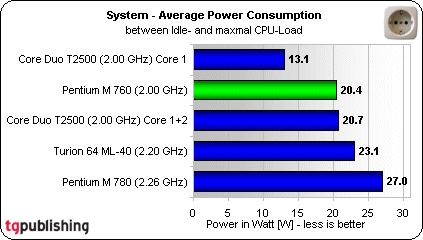Will Core Duo Notebooks Trade Battery Life For Quicker Response?
Energy Drain: Graphics Chip Or Chipset?
Next, let's take a look at the following three diagrams. The first one shows the power draw for the three test systems running in idle mode. The second illustrates what happened when we loaded the CPUs in all three notebooks as heavily as we could using the BurnMAX tool, and measured their power consumption. The final diagram shows the difference between the values read in idle mode versus those read under heavy load for all three candidates.
As you can see in the third chart, running either one of the two cores in the Core Duo T2500 processor at capacity boosts power consumption in the Centrino Duo system by about 13 Watts. When both cores are run at capacity, power consumption climbs by not quite 21 Watts. For an older Centrino system with a Pentium M, the power consumption under maximum load is also nearly 21 watts, even though a Pentium M 760 includes only one processing unit.
What can we conclude from these measurements? For one thing, the Core Duo T2500 is significantly better at conserving battery power than a Pentium M that runs at the same clock rate - at least, when only one core is heavily loaded, and the L2 cache isn't heavily used. Once you fire up both cores, the Duo starts to draw significantly more power. But even then, it's not drawing more, or perhaps only a small bit more, than a Pentium M 760.
By extension it follows logically that the abysmal results we obtained for battery life for the Centrino Duo test system while running the MobileMark 2005 benchmarks aren't caused by a power gobbling CPU. That's because its power consumption, usually stated in more approachable language as energy use, tops out at 21 Watts, which is in keeping with both our reasoning and our measurements.
So if that's true, where's the juice going? Is the graphics card consuming inordinate amounts of current? Might the logic that shuts down unused PCI Express lanes when used with dedicated GPUs be falling down on the job? This is a known problem that has already been observed in Sonoma systems, and discussed and documented with the developers, though never really said aloud in public nor officially acknowledged. Could it be that a substantial chunk of battery power is converted to heat in the brand-new ICH7-M chipset?
Many things are possible, but if we're willing to believe our well-informed sources, a problem with the USB 2.0 controller may be at fault. We can neither predict nor yet prove if this behavior will also apply to production notebooks in this series - remember, ours was a prototype. But we are convinced that Intel and other parties involved will be highly motivated to find and fix this problem as quickly as they can. It could even be the early stepping model of the chipset (NB Rev 03, SB Rev 02) that Asus built into our test machine.
Get Tom's Hardware's best news and in-depth reviews, straight to your inbox.
Current page: Energy Drain: Graphics Chip Or Chipset?
Prev Page MobileMark 2005, Continued Next Page Summary And Conclusions

